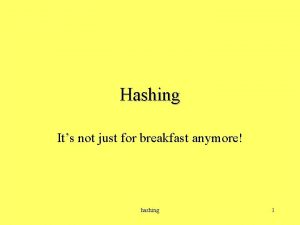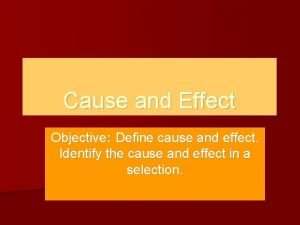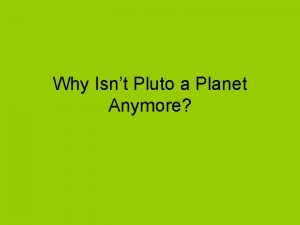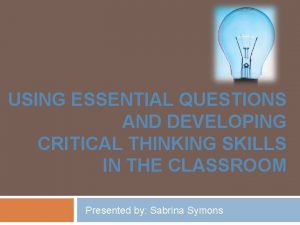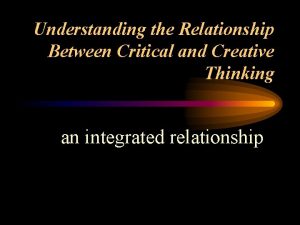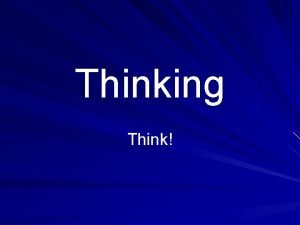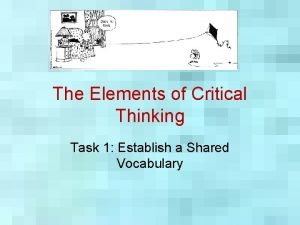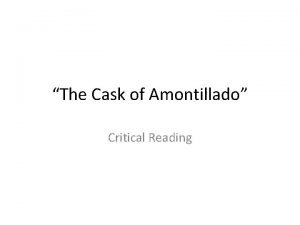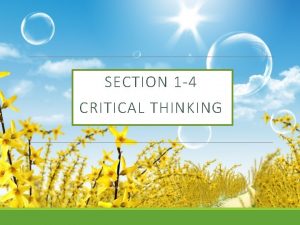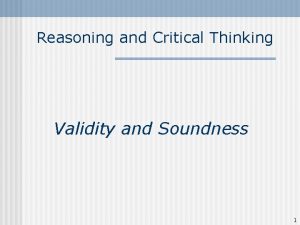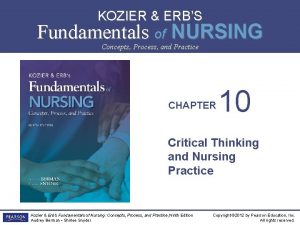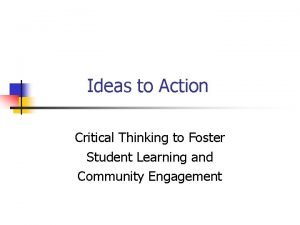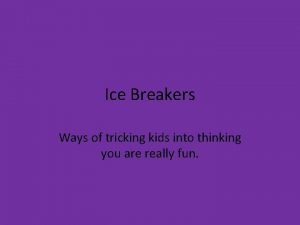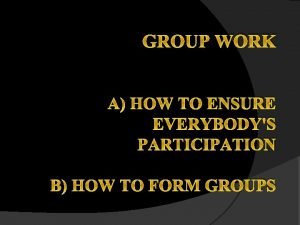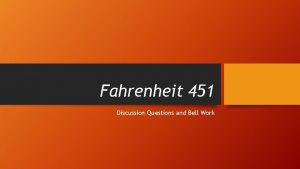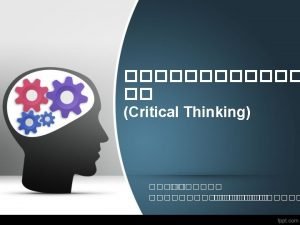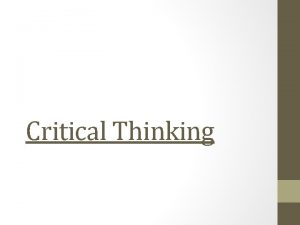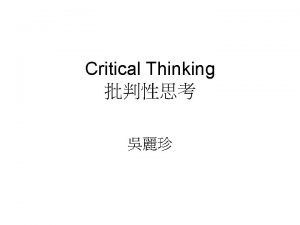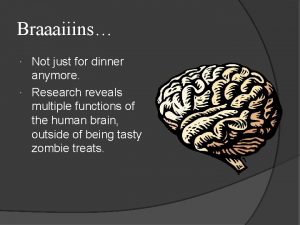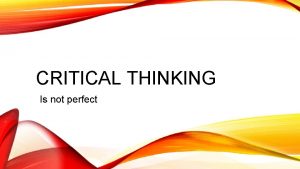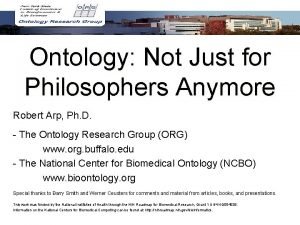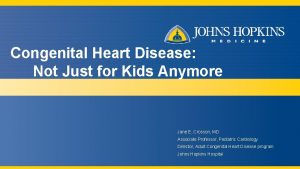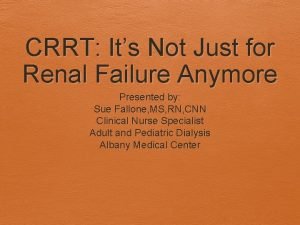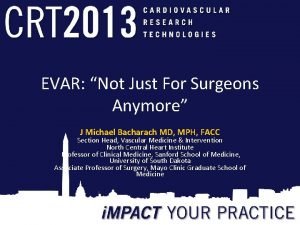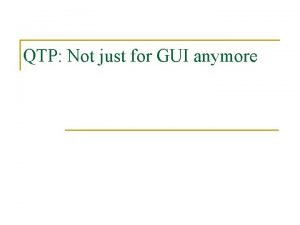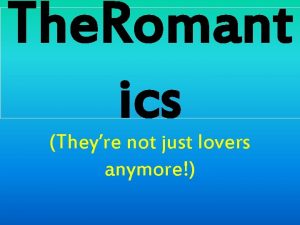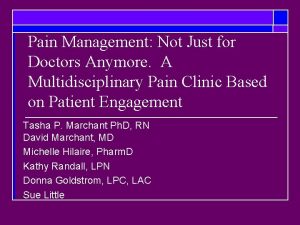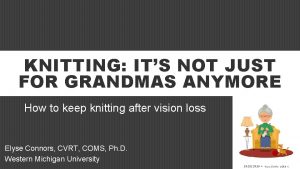Critical Thinking not just for research anymore Most



























- Slides: 27

Critical Thinking not just for research anymore

“Most people would sooner die than think, in fact they do. ” - Bertrand Russell

• What is “Critical Thinking” – Definitions and examples – Practice • • Common fallacies Qualities that foster critical thinking Obstacles to critical thinking Relationship to problem solving and decision making • Stages of development

What is Critical Thinking? • It is not, but includes: – Inference: essentially unconscious (recognition of analogous situations) – Thinking: conscious manipulation of information in the mind to some end result – Creativity: generating ideas

What is Critical Thinking? • It is – Reasoning: thinking with the addition of using a method. • The goal: to describe the world as accurately as possible. • Why? So w have confidence in our decisions. • From the Indo-European krei, meaning “to sift, cut, or separate”

What is Critical Thinking? • Reasoning process: – Logic, or deductive reasoning • From axiom to data • I. e. , from more to less (principle to example) – Generalizing, or inductive reasoning • From data to axiom • I. e. , from less to more (instances to principle) • Visualization tools (more right brain) • Verbal Tools (more left brain) • Procedural, or policy, tools

Logic, or deductive reasoning • Drawing conclusions, when the conclusion contains no more information than the premise from which it is drawn. – All jokes are funny; Jim is a joke; therefore Jim is a joke • Aristotle called the syllogisms (from the Greek, syn + logos = to reckon together)

The Venn diagram • If - then statements can be put into syllogistic or Venn format

What is Critical Thinking? • Reasoning process: – Logic, or deductive reasoning • From axiom to data • I. e. , from more to less (principle to example) – Generalizing, or inductive reasoning • From data to axiom • I. e. , from less to more (instances to principle) • Visualization tools (more right brain) • Verbal Tools (more left brain) • Procedural, or policy, tools

Generalizing, or inductive reasoning • Forming a conclusion, in which the conclusion contains more information than the premise from which it is drawn – My Windows OS is flawed – Her Windows OS is flawed – Therefore all Windows OS are flawed • Strong inference: from abundant data • Weak inferences: from sparse data

What is Critical Thinking? • Reasoning process: – Logic, or deductive reasoning • From axiom to data • I. e. , from more to less (principle to example) – Generalizing, or inductive reasoning • From data to axiom • I. e. , from less to more (instances to principle) • Visualization tools (more right brain) • Verbal Tools (more left brain) • Procedural, or policy, tools

Visualization tools • • • Generic diagrams Flow charts Gantt charts Organizational charts Rough sketches Scaled diagrams Network diagrams Surface maps System flow

Visualization tools • Domain-specific tools – Chemistry: equations, molecular models, bonding diagrams – Physics: Bohr’s particle state notation (dots), Feynman diagrams, force fields – English: sentence diagrams (yuke!) – Philosophy: truth tables, Venn diagrams – Math: graphs, histograms, matrices

What is Critical Thinking? • Reasoning process: – Logic, or deductive reasoning • From axiom to data • I. e. , from more to less (principle to example) – Generalizing, or inductive reasoning • From data to axiom • I. e. , from less to more (instances to principle) • Visualization tools (more right brain) • Verbal Tools (more left brain) • Procedural, or policy, tools

Verbal tools (more left brain) • • • Consensus Key word/statement format Open-ended questions Avoid “why” questions Debate Heuristics “Quaker” sermons Alternative explanations Simulations reframing

What is Critical Thinking? • Reasoning process: – Logic, or deductive reasoning • From axiom to data • I. e. , from more to less (principle to example) – Generalizing, or inductive reasoning • From data to axiom • I. e. , from less to more (instances to principle) • Visualization tools (more right brain) • Verbal Tools (more left brain) • Procedural, or policy, tools

Procedural, or policy, tools • • Independent confirmation Resisting the word of “experts” Multiple working hypotheses Regard your current situation as a chapter in your development, not your tombstone • Don’t diffuse the message

Procedural, or policy, tools • Quantify when possibe • All links in the logical chain must be strong • Occam’s razor • Insist that any hypothesis, in order to be accepted, also be capable of being falsified • Visualize where possible

Procedural, or policy, tools • Develop the habit of making a decision, identifying the reason for making it, as well as reasons for alternative decisions • Formulate all problems or goals in at least two ways • Prioritize information for relevance • When persuaded, identify the persuader and validate them (it) • Unearth or recognize any assumptions

Critical Thinking • Common fallacies (from the Latin, fallere, to deceive, trick, lead into error, trip) – Reason by analogy (A is true, B is like A, therefore B is true) – Ad moninen (attack the person, not the argument) – Hasty generalizations (statistics of small numbers; A 1 is B, A 2 is B, therefore all A are B) – Confirmatory bias (intentionally or conviently small sample is chosen) – Provincialism (We do it, therefore everbody does it; King Lear: “Our graces are righ honored”)

Critical Thinking • Misunderstanding statistics (half our school is below average; the law of averages) • Straw man - caricaturing to facilitate attack (tree huggers) • Non-sequitor - “finish your vegetables, kids in China are starving” • Arguing from what is to what ought to be (“If God had wanted us to _____, she would have made us ____”) • Begging the question (assuming the answer: We should teach children Latin so as adults they will be good analytical thinkers.

Critical Thinking • Self-deception (my sleep is more restful if I have dessert) • Equivocation (emphasizing one meaning over others) • False premise (based on assumptions many reject) • Quasi-science (the appearance of being scientific) • Argument from adverse consequence (“Do it, or you’ll be sorry”)

Critical Thinking • Observation selection (only counting what is think is correct) • Suppressed evidence • Wishful thinking (a conclusion with no foundation - if everybody would love each other, we’d have whirled peas) • Special pleading (How could an all-powerful God…? • Appeal to ignorance (can’t prove there are no flying saucers, so …)

Critical Thinking • Inconsistency: You take the cod liver oil, but I won’t • Slippery slope (Give them an inch, they’ll take a mile; if you allow 1 st term abortion, 3 rd term will soon follow) • Short term vs. long term (why spend money on jails when money on day care will prevent it)

Critical Thinking • Post hoc, ergo propter hoc (“after this, therefore because of this”) - I got fired after going on vacation, therefore I’ll never go on vacation again • Circularity (God did it because he is God) • Correlation-causation confusion (# of drunks and # of teachers (yes, correlated, but only because population is increasing)

Critical Thinking • Law of representativeness (librarians are like libraries) • Self-handicapping (sick, interruptions, namedropping, instructions not clear) • Weasel words (euphemisms: “police action” for war) • Excluded middle (black or white, no grey) • Mistaking chance for a pattern

Critical Thinking • Brokaw Effect (need base line - shallow breathing not necessarily stress/deceit) • Othello Hazard (Desdemona’s unease stress not necessaril a sign of deceit; could be a sign of fear of not being believed)
 Its not just anymore
Its not just anymore How to read civil drawings
How to read civil drawings Betsy was lonely. what caused this
Betsy was lonely. what caused this Critical semi critical and non critical instruments
Critical semi critical and non critical instruments Semi-critical
Semi-critical Perbedaan critical thinking dan creative thinking
Perbedaan critical thinking dan creative thinking Just about right scale
Just about right scale Pluto planta
Pluto planta Did paris love juliet give evidence to support your answer
Did paris love juliet give evidence to support your answer Vocabulary workshop level d unit 1
Vocabulary workshop level d unit 1 Critical reading meaning
Critical reading meaning Which is the hardest
Which is the hardest Critical thinking guidelines
Critical thinking guidelines Critical thinking examples
Critical thinking examples Relationship between creative and critical thinking
Relationship between creative and critical thinking Critical thinking examples in real life
Critical thinking examples in real life Nosich elements of critical thinking
Nosich elements of critical thinking Montresor acts as judge jury and executioner of fortunato
Montresor acts as judge jury and executioner of fortunato Critical thinking examples
Critical thinking examples Validity in critical thinking
Validity in critical thinking Active learning strategies to promote critical thinking
Active learning strategies to promote critical thinking Levels of critical thinking in nursing
Levels of critical thinking in nursing 5 components of critical thinking
5 components of critical thinking Alliteration game ice breaker
Alliteration game ice breaker Critical thinking in group work
Critical thinking in group work Fahrenheit 451 critical thinking questions
Fahrenheit 451 critical thinking questions Critical thinking definition
Critical thinking definition Wiki critical thinking
Wiki critical thinking
